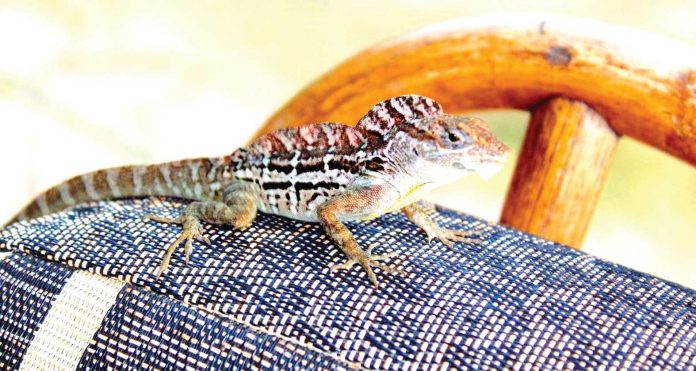The striped anole (Anolis lineatus) is known as waltaca in Papiamento, which must have been probably an Arawakan name. Waltaca is a species of lizard in the family Dactyloidae. Ours is native to Aruba and Curacao, and has been introduced to Klein Curacao.
Anolis lineatus is from South America origin and belongs to the so-called group Anolis nitens. Anolis nitens is a strain from Venezuela and the Guyanas, which contains some subspecies. English denomination: Anole stripes.
Waltacas are territorial animals, they have their own zone that they guard from other waltacas and here in our garden you can find them guarding their favorite tree trunk or spot on a rock. They even have a favorite chair when it’s time to catch a fly. As you can see in the photo, it blends in perfectly with the patterns of the chair fabric. Great camouflage, color and tone changing abilities can be useful when hunting and in the delicate balance between communication, protection or thermoregulation.
It is generally common in the more densely vegetated part of our garden since it is less dry and shady at Etnia Nativa. You will observe that it is a small agile arboreal lizard that usually sits with its head down on the trunk and threaten to “Double chin” any possible intruders. Males have a larger “dewlap” than females. The “double chin” is orange with black in the throat stripe and a thin yellow border on the outer edge.
In Aruba waltacas are usually found in dry tropical shrub land at all elevations in its range, but is uncommon in habitats without larger trees. It can often be seen on rocks, the walls of buildings or tree trunks; at various heights but often relatively close to the ground.
Males reach about 7–7.5 cm (2.8–3.0 in) in snout-to-vent length and the females about 6 cm (2.4 in).
In its overall waltacas are light brownish with a dark-edged pale lateral stripe on each side, and typically several light bars on the body and tail. It has an orange-yellow dewlap with a blackish spot; the dewlap is significantly larger in males than in females. It is the only known species of anole where the dewlap is asymmetrically colored, being deeper orange on one side and yellower on the other. In almost three-quarter of all individuals the left side is the most yellow. The color difference between the two sides is indistinct in only a minority of the females. They are light gray at the bottom. Just like iguanas they can also change color, but the color only varies with light darker. When they’re scared or excited, they can suddenly get a lot darker. Striped pattern is sharpest in the Aruba shape of Anolis lineatus border.q
To get to know more regarding Aruba’s and its origins, its animals culture etc. We highly recommend you to book your participation. Living our cultural encounter session is mind opening and entertaining curious hearts for decades. Mail us at etnianativa03@gmail.com. Our facilities and activities take place close to your place.















